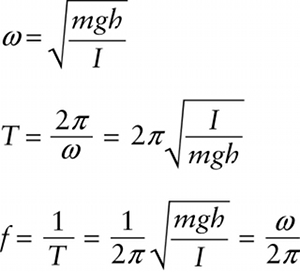Angular frequency, period, and frequency for a physical pendulum (small amplitude) (12-31)
Question 1 of 3
Question
Angular frequency
{"title":"Angular frequency","description":"Correct!","type":"correct","color":"#99CCFF","code":"[{\"shape\":\"poly\",\"coords\":\"82,133\"},{\"shape\":\"rect\",\"coords\":\"2,29,23,50\"}]"} {"title":"Period","description":"Wrong","type":"incorrect","color":"#ffcc00","code":"[{\"shape\":\"rect\",\"coords\":\"118,11,119,13\"},{\"shape\":\"rect\",\"coords\":\"1,124,19,148\"}]"} {"title":"Frequency","description":"Incorrect","type":"incorrect","color":"#333300","code":"[{\"shape\":\"rect\",\"coords\":\"1,221,16,257\"}]"}Review
Compare Equation 12-30 to the corresponding equation for the simple pendulum that we derived in Section 12-5, αz≈−(g/L)θ (Equation 12-26): The equation is identical except that g/L has been replaced by mgh/I. So we conclude that just as for the simple pendulum, the oscillations of a physical pendulum are simple harmonic motion provided that the amplitude is relatively small. To find the angular frequency, period, and frequency of a physical pendulum, we simply take Equations 12-27 for a simple pendulum and replace g/L with mgh/I:

